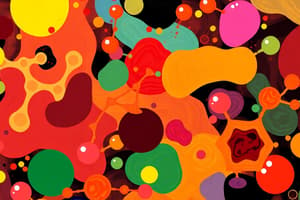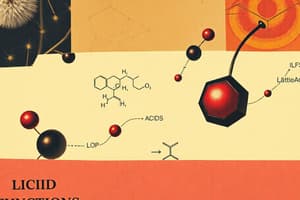Podcast
Questions and Answers
What is the primary function of steroids in the human body?
What is the primary function of steroids in the human body?
- To store energy for the body
- To act as signaling molecules for various biological processes (correct)
- To form the major component of cell membranes
- To provide structural support to cells
Which of the following statements about fat cells is INCORRECT?
Which of the following statements about fat cells is INCORRECT?
- You can permanently eliminate fat cells by losing weight. (correct)
- Fat cells can shrink in size when you lose weight but they never disappear.
- The average human body contains between 10 billion and 30 billion fat cells.
- Fat cells are capable of storing energy for the body.
Which hormone is primarily responsible for regulating carbohydrate, protein, and lipid metabolism?
Which hormone is primarily responsible for regulating carbohydrate, protein, and lipid metabolism?
- Cortisol (correct)
- Progesterone
- Testosterone
- Estradiol
What is the key structural feature that distinguishes steroids from other lipids?
What is the key structural feature that distinguishes steroids from other lipids?
Which of these is NOT a function of lipids in the body?
Which of these is NOT a function of lipids in the body?
Flashcards
Lipids
Lipids
A diverse group of molecules defined by low solubility in water, including fats, phospholipids, and steroids.
Phospholipids
Phospholipids
A type of lipid that forms cell membranes, consisting of two fatty acids and a phosphate group attached to a glycerol backbone.
Steroids
Steroids
A family of lipids characterized by a core structure of four fused carbon rings, important for hormones and cholesterol.
Cholesterol
Cholesterol
Signup and view all the flashcards
Fat Cells
Fat Cells
Signup and view all the flashcards
Study Notes
Lipids
- Defined by low solubility in water
- Not polymers
- Important biological molecules include fats, phospholipids, and steroids
Types of Lipids
- Fatty Acids:
- Vary in length (number of carbons) and in the number and locations of double bonds
- Types include short-chain (2-4 carbons), medium-chain (6-10 carbons), and long-chain (12 or more carbons)
- Examples: Butyric (C4:0), Caprylic (C8:0), Palmitic (C16:0)
- Saturated Fatty Acids:
- Have no double bonds
- Solid at room temperature
- Example: Stearic acid
- Unsaturated Fatty Acids:
- Have one or more double bonds
- Liquid at room temperature
- Examples: Oleic acid
- Cis double bonds cause bending
- Triglycerides:
- One glycerol backbone and three fatty acids
- Model: Glycerol backbone with three fatty acid chains (Sn1, Sn2, Sn3 positions)
- Phosphoglycerides:
- Glycerol backbone, two fatty acid chains, and a phosphate group
- Hydrophilic heads and hydrophobic tails
- Example: Phospholipids
- Steroids:
- Four fused carbon rings (17 carbon atoms)
- Steroid nucleus
- Found in plants and animals
- Examples: Cholesterol, sex hormones (testosterone, estradiol), adrenocorticoid hormones (cortisol), bile acids
- Waxes:
- Long-chain alcohols esterified to long-chain fatty acids
- Example: beeswax (triacontanol palmitate)
- Sphingolipids:
- Sphingosine or 4-sphingonine backbone
- Important for animal membrane components (nerve tissue)
- Sphingomyelin: myelin sheath component.
- Cerebroside: Sugar, glucose or galactose.
- Sulfatide: Sugar, galactose with sulfate esterified
- Gangliosides: Ceramide with three or more sugars (including sialic acid)
Hydrogenated Fats
- Polyunsaturated vegetable oils with added hydrogen
- Make them solid at room temperature
- Process called hydrogenation
- Examples: Crisco, margarine, shortening
Trans-Fatty Acids (TFAs)
- Produced when hydrogen atoms are added to monounsaturated or polyunsaturated fats
- Raise low-density lipoproteins (LDL) and total cholesterol
- Major source: baked goods and restaurant foods
Lipid Transport
- Lipoproteins are vehicles for lipid transport
- Four types: Chylomicrons, VLDL, LDL, HDL
- Sizes and compositions vary
- Chylomicrons: Largest, least dense, transport dietary lipids
- VLDL: Transport triglycerides to tissues
- LDL: Transport cholesterol to tissues, high cholesterol.
- HDL: Transport cholesterol from tissues to liver for removal
Additional Notes
- Average human body contains 10-30 billion fat cells
- Losing weight shrinks fat cells but they can refill
- Fats are crucial for bodily functions beyond weight gain; necessary for many important bodily processes.
Studying That Suits You
Use AI to generate personalized quizzes and flashcards to suit your learning preferences.




